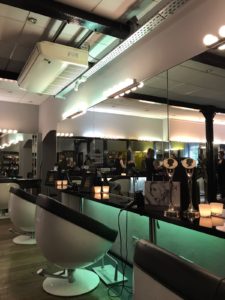Award-winning hairdresser aims salon for sensory sufferers.
Lisa Shepherd is one of the country’s best-loved hairdressers, acclaimed for her colour know-how, savvy business skills and an ability to make women feel fantastic about themselves.
However, Lisa’s career was almost cut short, when a terrifying incident left her physically unable to work in the one place she’d always felt most at home: the salon. In December 2016, Lisa suffered a Tonic-Clonic seizure (once known as a grand mal). This frightening event is what most people think of when they think of a seizure; causing convulsions and a loss of consciousness. Lisa suffered impact to her head which led to concussion, but beyond that also caused lasting damage to her vestibular system – the sensory system which helps with balance and spatial orientation. In fact, it was impaired by almost 50%, causing a major disconnect between the brain, eyes and limbs. On top of this, she now also suffers from light-sensitive epilepsy.
 This tragic incident meant that salon life no longer felt like an option for Lisa, despite it being the place she most wanted to be. Visual stimulants like colours, light and motion caused intense physical pain, while anxiety and panic attacks also flared up in the now-hostile surroundings.
This tragic incident meant that salon life no longer felt like an option for Lisa, despite it being the place she most wanted to be. Visual stimulants like colours, light and motion caused intense physical pain, while anxiety and panic attacks also flared up in the now-hostile surroundings.
With a lifelong love of hairdressing and a problem solving business brain which had already seen her launch smart initiatives like the Color Bar, Lisa decided to take matters into her own hands and radically alter her salon to make it a place where she – and others living with similar illnesses –would feel safe and welcome.
Lisa’s game-changing low sensory salon includes a series of smart initiatives, all designed to provide alternatives to standard facilities. Lighting is one of the biggest triggers for those with chronic illness, but is also one of the most important factors for a salon. In Lisa’s Kidderminster space, more than 100 spotlights were removed and the remaining ones fitted with low-voltage bulbs and filters to create a lower level of brightness. Stylists have softened, but carefully positioned, lighting around their mirrors and use head lamps for close-up colour work.
Instead of stark white walls, the salon is now painted a muted grey to further soften the space. Music can also be an issue, which is why the salon now only plays quiet, meditative options. Clients are encouraged to focus on breathing methods and meditation, particularly while their colour is developing. At the backwash, there’s no lighting at all at eyeline. Clients are provided with eye masks and earplugs, so that they can focus fully on enjoying a massage and relaxing. Lisa’s physio therapist has also visited the salon to train staff in Ayuvedic vestibular and cranial massage, for a truly blissful and therapeutic backwash experience.
Even refreshments are considered, with no caffeinated drinks on offer – only decaf options, herbal teas and water. Peppermint, which is great for mind stability, also features in the salon, with candles burning to create a more relaxed and stable environment. The salon now opens specifically on Mondays for clients who require a low-sensory salon experience, but demand was so great that there are now designated times throughout the week to help fit everyone in. This previously unknown and unprovided gap in the market means that anyone living with chronic illness can feel safe and enjoy great hair without triggering fits and causing undue stress.
While vestibular disorders are rare, there are plenty of people living with anxiety and illnesses which make the salon a hostile place to be. “As an industry,we could be more aware of mental health and chronic illness,” says Lisa. “We could be a lot more helpful. My aim to raise awareness of just how many people are alienated from a salon experience and we have it in our hands to change this and make the salon a positive experience and a safe place for them.”
She continues: “The salon still runs at the same pace and our ethos hasn’t changed; we still deliver the best colour around but now it’s in a zero-stress environment which feels more like a spa. Not only is it better for our clients, but it’s better for my team too. I feel that by making these changes, it will hopefully lead them to a better future and make the workplace a much nicer place to be day-to-day.”
For more information visit www.lisashepherd.co.uk


